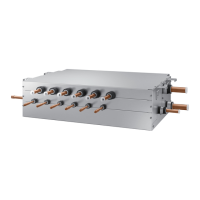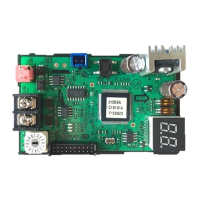15
5. Select the insulation of the refrigerant pipe.
X
Insulate the gas side and liquid side pipe referring to the thickness according to the pipe size.
X
Indoor temperature of 30°C(86°F) and humidity of 85% is the standard condition. If install in a high humidity condition, use one grade
thicker insulator by referring to the table below. If installing in an unfavorable conditions,use thicker one.
X
Insulator’s heat-resistance temperature should be more than 120°C
(248°F)
.
Pipe
Outer diameter
Insulator (Cooling, Heating)
Remarks
General
[30°C (86°F)
, 85%
]
High humidity
[30°C (86°F)
, over 85%
]
EPDM, NBR
mm inch mm inch mm inch
Liquid
pipe
6.35~9.52 1/4~3/8 9 3/8 9 3/8
Heating resisting
temperature over
120°C (248°F)
12.70~50.80 1/2~2 13 1/2 13 1/2
Gas
Pipe
6.35 1/4 13 1/2 19 3/4
9.52~25.4 3/8~1 19 3/4 25 1
28.58~44.45 1 1/8~1 3/4 19 3/4 32 1 1/4
50.80 2 25 1 38 1 1/2
Refrigerant pipe before EEV kit and MCU or without EEV kit and MCU
f You can contact the gas side and liquid side pipes but the pipes
should not be pressed.
fWhen contacting the gas side and gas side pipe, use 1 grade thicker
insulator.
Refrigerant pipe after EEV kit and MCU
f
Install the gas side and liquid side pipes, leave 10mm(3/8") of
space.
f
When contacting the gas side and liquid side pipe, use 1 grade
thicker insulation.
Gas pipe
Liquid pipe
Insulation
Insulation
Gas pipe
10mm(3/8")
Liquid pipe
10mm(3/8")
10mm(3/8")
• Install the insulation not to get wider and use the adhesives on the connection part of it to
prevent moisture from entering.
• Wind the refrigerant pipe with insulation tape
if it is exposed to outside sunlight.
• Install the refrigerant pipe respecting that the
insulation does not get thinner on the bent
part or hanger of pipe.
• Add the additional insulation
if the insulation plate gets thinner.
Additional insulation
Hanger
Refrigerant pipe insulation
a×3
a
• Installez le matériau isolant de sorte qu'il ne s'élargisse pas et utilisez les adhésifs situés sur la pièce de
raccordement de celui-ci pour empêcher l'humidité de pénétrer.
• Enroulez le tuyau réfrigérant avec du ruban
isolant s'il est exposé à la lumière du jour.
• Installez le tuyau réfrigérant de manière à ce que
l'isolation ne s'affine pas au niveau de la partie
courbée ou du support du tuyau.
• Ajoutez du matériau isolant si la plaque
d'isolation devient plus ne.
Isolation
supplémentaire
Support
Isolation des tuyaux
réfrigérants
a×3
a

